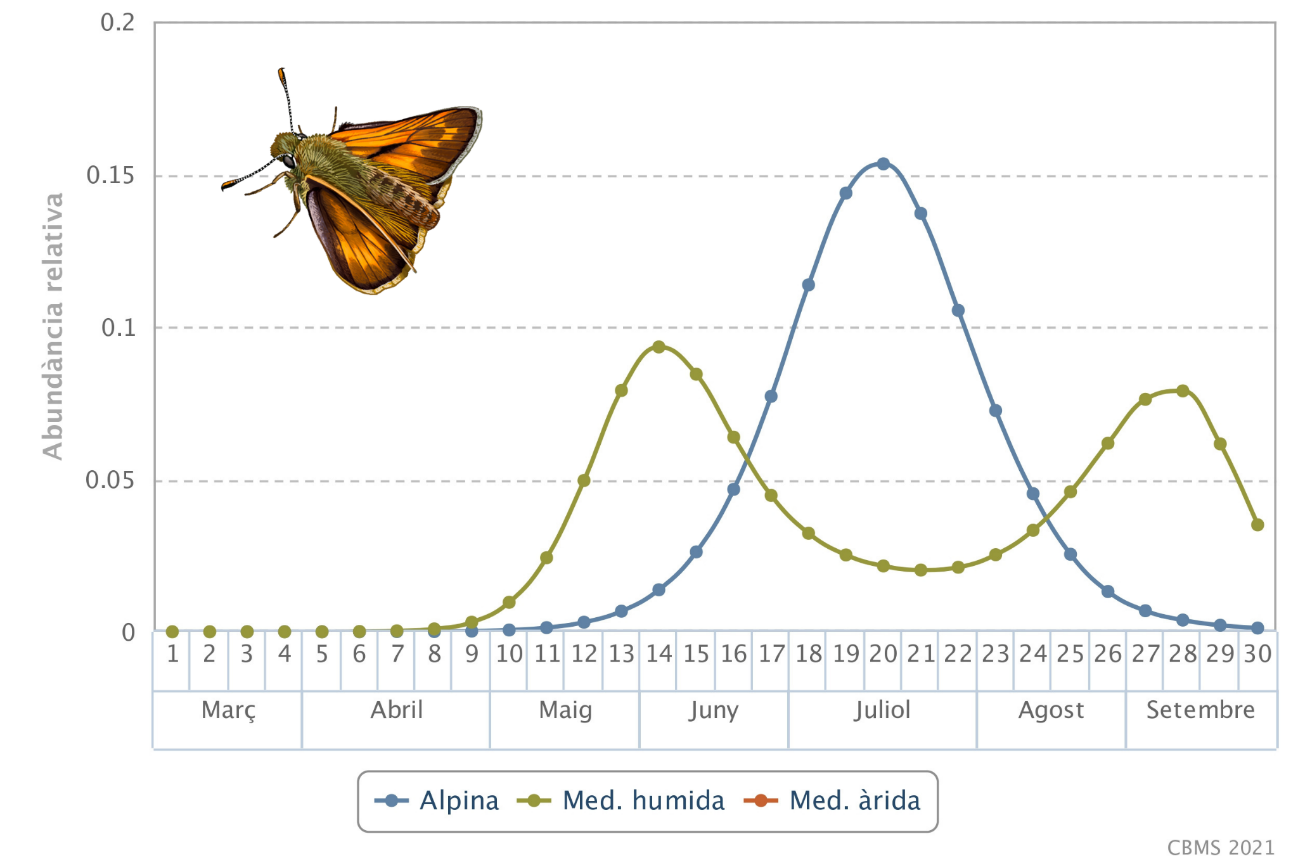Research lines
Climate change impact on biodiversity
Butterflies are ideal for detecting climate change effects on our ecosystems because (1) as ectothermic organisms they are highly dependent on ambient temperature; (2) like most insects, they have very short generation cycles, which is manifested in [More ...] rapid responses to changes in temperature and rainfall patterns; (3) the existence of monitoring programs makes it possible to obtain very precise information on the flight periods and abundance of species, and to analyze their variations in relation to climatic factors; (4) there is ample historical data in entomological collections that allow us to reconstruct changes in species distribution related to climate change.
CBMS data is used to investigate how butterfly phenology (e.g. flight periods) is affected by climate change and, also, how these responses in turn affect butterfly abundance. Likewise, CBMS data is used to understand which climate factors have the greatest impact on butterfly populations, both positively and negatively, and how these effects vary according to the geographic and climatic region.

Monitoring data provided by the CBMS makes it possible to model the flight curves of butterflies with great precision, and to study the differences between geographical regions and between seasons. The Large Skipper (Ochlodes sylvanus), for example, completes a single annual summer generation in the high mountains, but two in Mediterranean environments, a first in late spring and a second in late summer and early autumn.
- Carnicer, J., Stefanescu, C., Vives-Ingla, M., López, C., Cortizas, S., Wheat, C., Vila, R., Llusià, J., Peñuelas, J. (2019). Phenotypic biomarkers of climatic impacts on declining insect populations: a key role for decadal drought, thermal buffering and amplification effects and host plant dynamics. Journal of Animal Ecology, 88: 376-391
- Colom, P., Ninyerola, M., Pons, X., Traveset, A., Stefanescu, C. (2022). Phenological sensitivity and seasonal variability explain climate-driven trends in Mediterranean butterflies. Proceedings of the Royal Society B, 20220251. DOI 10.1098/rspb.2022.0251
- Colom, P., Traveset, A., Carreras, D., Stefanescu, C. (2021). Spatio-temporal responses of butterflies to global warming on a Mediterranean island over two decades. Ecological Entomology, 46: 262-272. DOI 10.1111/een.12958
- Devictor, V., van Swaay, C., Brereton, T., Brotons, L., Chamberlain, D., Heliölä, J., Herrando, S., Julliard, R., Kuussaari, M., Lindström, Å., Reif , J., Roy, D.B., Schweiger, O., Settele, J., Stefanescu, C., Van Strien, A. Van, Turnhout, C., Vermouzek, Z., DeVries, M.W., Wynhoff, I. & Jiguet, F. (2012). Differences in the climatic debts of birds and butterflies at a continental scale. Nature Climate Change, 2: 121-124.
- Donoso, I., Stefanescu, C., Martínez-Abraín, A. & Traveset, A. (2016). Phenological asynchrony in plant-butterfly interactions associated with climate: a community-wide perspective. Oikos.
- Evans, L.C., Melero, Y., Schmucki, R., Boersch-Supan, P.H., Brotons, Ll., Fontaine, C., Jiguet, F., Kuussaari, M., Massimino, D., Robinson, R.A., Roy, D.B., Schweiger, O., Settele, J., Stefanescu, C., van Turnhout, C.A.M., Oliver, T.H. (2022). Bioclimatic context of species’ populations determines community stability. Global Ecology and Biogeography. DOI 10.1111/geb.13527
- Herrando, S., Titeux, N., Brotons, L., Anton, M., Ubach, A., Villero, D., García-Barros, E, Munguira, M.L, Godinho, C., Stefanescu, C. (2019). Contrasting impacts of precipitation on Mediterranean birds and butterflies. Scientific Reports, 9: 5680. DOI 10.1038/s41598-019-4217
- Mills, S.C., Oliver, T.H., Bradbury, R.B., Gregory, R.D., Brereton, T., Kühn, E., Kuussaari, M., Musche, M., Roy, D.B., Schmucki, R., Stefanescu, C., van Swaay, C., Evans, K.L. (2017). European butterfly populations vary in sensitivity to weather across their geographical ranges. Global Ecology and Biogeography, 26: 1374-1385. DOI 10.1111/geb.12659
- Radchuk, V., Reed, T., ... , Kramer-Schadt, S. (2019). Adaptive responses of animals to climate change are most likely insufficient. Nature communications, 10:3109. DOI 10.1038/s41467-019-10924-4
- Stefanescu, C. (2021). El declive de las mariposas mediterráneas. Investigación y Ciencia, 40-47.
- Stefanescu, C., Carnicer, J. & Peñuelas, J. (2011). Determinants of species richness in generalist and specialist Mediterranean butterfly: the negative synergistic forces of climate and habitat change. Ecography, 34: 353-363.
- Stefanescu, C., Peñuelas, J. & Filella, I. (2003). Effects of climatic change on the phenology of butterflies in the northwest Mediterranean Basin. Global Change Biology, 9: 1494-1506.
- Suggitt, A.J., Stefanescu, C., Oliver, T., Páramo, F., Anderson, B.J., Hill, J.K., Roy, D.B. & Thomas, C.D., 2012. Habitat associations of species show consistent but weak responses to climate. Biology Letters, 8: 590-593.
- Ubach, A., Páramo, F., Prohom, M, Stefanescu, C. (2022). Weather and butterfly responses: a framework for understanding population dynamics in terms of species’ life-cycles and extreme climatic events. Oecologia. DOI 10.1007/s00442-022-05188-7
Recommended references




